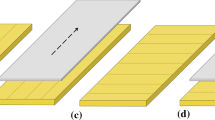Abstract
Nowadays, wood-based panel producers intend to lower costs by decreasing the pressing time and reducing resin consumption. Therefore, the aim of this work is to understand the influence of the pressing operating conditions (pressing time and pressing program) on the performance of particleboards (PBs) bonded with a UF resin (alkaline–acid process). For this purpose, several trials were carried out using a computer-controlled laboratory scale hot-press with a press cycle simulating a continuous press and a fixed position laboratory scale hot-press, varying the venting, the total pressing time (< 90 s, 90 s and > 90 s) and the gluing factor (resin content—4, 5 and 6 mg resin solids/g oven dry wood). Analysis of variance (ANOVA) was performed in order to evaluate the significance level of the effects of these parameters on PB’s physico-mechanical properties and formaldehyde content. The main results of the study were: to decrease formaldehyde content, resin content (RC) should be increased for pressing times higher or equal to 90 s or decreased for pressing times lower than 90 s; to increase internal bond, RC must be increased for pressing times equal or higher than 90 s, or decreased for pressing times lower than 90 s.











Similar content being viewed by others
References
Carvalho LH, Costa M (1998) Modeling and simulation of the hot-pressing process in the production of medium density fiberboard (MDF). Chem Eng Commun 170:1–20
Carvalho LH, Costa MR, Costa C (2003) A global model for the hot-pressing of MDF. Wood Sci Technol 37:241–258
Carvalho LH, Martins J, Costa C (2010) Transport phenomena, wood-based panels—an introduction for specialists. Brunel University Press, London
Dai C, Yu C (2004) Heat and mass transfer in wood composite panels during hot-pressing: part I. A physical–mathematical model. Wood Fiber Sci 36:585–597
Dai C, Wasylciw W, Jin J (2004) Comparison of the pressing behaviour of wood particleboard and strawboard. Wood Sci Technol 38:529–537
Dunky M (1998) Urea–formaldehyde (UF) adhesive resins for wood. Int J Adhes Adhes 18:95–107
Gonçalves C, Paiva NT, Ferra JM, Martins J, Magalhães F, Barros-Timmons A, Carvalho LH (2018) Utilization and characterization of amino resins for the production of wood-based panels with emphasis on particleboards (PB) and medium density fibreboards (MDF). A review. Holzforschung 66:849–856
Humphrey P, Bolton P, Kavvouras P (1989) The hot pressing of dry-formed wood-based composites. Part III. Predicted vapour pressure and temperature variation with time, compared with experimental data for laboratory boards. Holzforschung 43:265–274
Kelley M (1977) Critical literature review of relationship between processing parameters and physical properties of particleboard. US Department of Agriculture Forest Service Forest Product Laboratory Madison, WIS
Maku T, Hamada R, Sasaki H (1959) Studies on the particleboard. Report 4: temperature and moisture distribution in particleboard during hot-pressing. Kurenai University of Kioto 21:34–46
Maloney T (1989) Modern particleboard and dry-process fiberboard manufacturing. Miller Freeman Publications, San Francisco
Martins J, Vasconcelos E, Pereira J, Ferra J, Cruz P, Magalhães P, Carvalho LH (2012) A new methodology to predict the optimum pressing time for wood-based panels produced with low formaldehyde emission resins. 66th international conventional. Forest Products Society, Washington
Park B-D, Kim YS, Singh AP, Lim KP (2003) Reactivity, chemical structure, and molecular mobility of urea–formaldehyde adhesives synthesized under different conditions using FTIR and solid-state 13 C CP/MAS NMR spectroscopy. J Appl Polym Sci 88:2677–2687
Pereira C, Carvalho LH, Costa C (2006) Modeling the continuous hot-pressing of MDF. Wood Sci Technol 40:308–326
Pizzi A, Mittal K (2003) Handbook of adhesive technology, 2nd edn. Marcel Dekker Inc., New York
Strickler MD (1959) Effects of press cycle and moisture content on properties of Douglas-fir flakeboard. For Prod J 9:203–215
Thoemen H, Humphrey P (2001) Hot pressing of wood-based composites: selected aspects of the physics investigated by means of simulation. In: Proceedings of the 5th European Panel Products Symposium, Llandudno, North Wales, UK, pp 38–49
Thoemen H, Humphrey P (2006) Modeling the physical processes relevant during hot pressing of wood-based composites. Part I. Heat and mass transfer. Holz Roh Werkst 64:1–10
Zombori B (2001) Modeling the transient effects during the hot-pressing of wood-based composites. Chap. 2. Simulation of the mat formation process. In: Model transient Eff. Dur. hot-pressing wood-based Compos., pp 8–40
Zombori B, Kamke F, Watson L (2003) Simulation of the internal conditions during the hot-pressing process. Wood Fiber Sci 35:2–23
Acknowledgements
Carolina Gonçalves thanks ENGIQ—Doctoral Programme in Refining, Petrochemical and Chemical Engineering (PDERPQ); FCT and EuroResinas—Indústrias Químicas for the PhD grant PD/BDE/114352/2016. This work was financially supported by: Project POCI-01-0145-FEDER-006939 (Laboratory for Process Engineering, Environment, Biotechnology and Energy—UID/EQU/00511/2013) funded by the European Regional Development Fund (ERDF), through COMPETE2020—Programa Operacional Competitividade e Internacionalização (POCI) and by national funds, through FCT—Fundação para a Ciência e a Tecnologia; the project CICECO-Aveiro Institute of Materials, POCI-01-0145-FEDER-007679 (FCT Ref. UID/CTM /50011/2013), financed by national funds through the FCT/MEC and when appropriate co-financed by FEDER under the PT2020 Partnership Agreement and 2GAR project under PT2020.
Author information
Authors and Affiliations
Corresponding author
Ethics declarations
Conflict of Interest
The authors declare that they have no conflict of interest.
Additional information
Publisher’s Note
Springer Nature remains neutral with regard to jurisdictional claims in published maps and institutional affiliations.
Rights and permissions
About this article
Cite this article
Gonçalves, C., Pereira, J., Paiva, N.T. et al. A study of the influence of press parameters on particleboards’ performance. Eur. J. Wood Prod. 78, 333–341 (2020). https://doi.org/10.1007/s00107-020-01507-y
Received:
Published:
Issue Date:
DOI: https://doi.org/10.1007/s00107-020-01507-y




